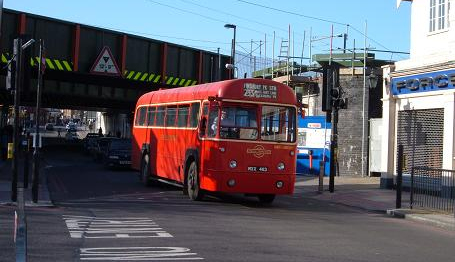
Finsbury Park termini
Page last updated 21 September
2019
London in microcosm - a detailed look at the changing terminal
workings at Finsbury Park over the years. This north London
station has been a transport hub since Victorian times and its
narrow streets and low bridge have added complexity to its bus
services. It also hosted no fewer than 4 red RF routes.
The Great Divide.
The low bridge at Finsbury Park Station over Stroud Green Road
effectively divides services from the north-west from the rest of
the network. Wells Terrace is under the bridge to the left,
Station Place is to the left of the foreground. It should be
pointed out that the 233 never ran under the bridge - RF486 in
March 2005 has finished its run over the 233 and heads home.
It is a few yards behind the location of RF433 in this mid-60s
shot outside the Majestic Ballroom (John Hinson
collection). Photo © Peter Osborn
Buses have terminated at the following locations at Finsbury
Park:
We have pieced together information from a wide range of
sources for this item, but it is likely that there are errors and
omissions - as ever, comments and corrections welcome.
First, an introduction to the area.
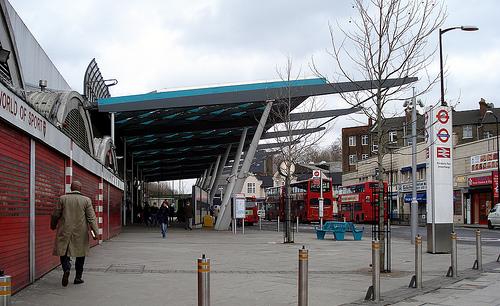
The railway station
The main entrance to Finsbury Park Station as
it is today, with the Station Place Bus Station. The old
Majestic Ballroom
survives in the background. Photo © Kake Pugh
Finsbury Park Station is on the east coast main line and
opened in 1861, then being called Seven Sisters Road. A
branch line to Edgware, with platforms either side of the main
line, opened in 1867 and closed in 1970 (the pre-war plan to
extend the Northern Line from Moorgate along this line to Highgate
having been abandoned). Incidentally, an
1873 branch of this line, from Highgate to Alexandra
Palace, passed under Muswell Hill by the weak bridge that
caused much expense to London Transport, requiring the 212 to be single-deck operated. The
unused
superstructure erected for the Northern Heights project dominated Station
Place for years until demolished in 1972.
The main line was joined by the Underground in 1904 when the
Northern Line shuttle from Moorgate opened. The
Piccadilly Line opened between Finsbury Park and Hammersmith in
1906 and was extended northwards in 1932, prior to which the
resulting transport bottle-neck would have provided major
traffic to the buses. The underground Northern
Line terminus closed in 1964 and some parts of it were used
for the Victoria Line, which opened in 1968. The former
Northern Line from Moorgate was later rebuilt with an
above-ground junction, opening as a British Rail line in
1976.
The railway line crosses both Seven Sisters Road and Stroud
Green Road, the latter over a low bridge (12'9"). Perhaps for
this reason, services from the Stroud Green direction have
generally terminated west of the railway, with only a limited
service joining east and west (and none since 1982).
The main entrance to the station is on the east side of the
line, in Station Place (formerly Station Road). Additional
entrances are sited in Wells Terrace, on the Stroud Green side of
the station, and on Seven Sisters Road.

Coal
RF453 on the 212 stand
under the Smallwood's (or was it Smart's?) Coal Yard bridge in
1954. The 233 used the first (more distant) stand.
Photo © DF
Parker, John Hinson collection
Before moving on to the bus services themselves, it is worth
recalling the dominance of coal as a heating fuel in London's
homes until the 50s and 60s - the first Clean Air Act was passed in
1956 after the severe 5-day smog of 1952 (the Mayor of London's
2002 report on air quality, precursor to the controversial London
Low Emission Zone, had as its cover a striking picture of an
RTW in the 1952 smog). It was only later that solid fuel
generally gave way to gas- or electric-fired central
heating.
There was a substantial infrastructure required to transport
the coal that was used in London's homes and
businesses. It was primarily carried by rail to local
depots, with coal yards (such as the one
in Muswell Hill) dotting the city. One such was adjacent
to Finsbury Park Station alongside Clifton Terrace, served by a
branch line that crossed Wells Terrace. This line closed in
the 1960s and the bridge was removed in 1970. See the 1954 OS
map here.
Buses, trams and trolleybuses
Details of bus workings are summarised below, separately for
each of the separate termini. Trams and trolleybuses are
outside the scope of this site, but it is worth noting that the LCC
horse trams (electrified in 1908) and the MET trams (electrified in
1904) served Finsbury Park from the south-west and north-east
respectively, but were not connected until 1912. LCC had a
depot opposite the end of Blackhorse Road. Trams were
replaced by trolleybuses in 1938-9, and routes 521, 621, 627,
629, 653, 659 and 679 used Seven Sisters Road. Some of these used
the turning loop at Finsbury Park and the stand in Coleridge Road
for short workings.
Maps of terminal workings
Click for a larger version
Map base © Streetmap.co.uk
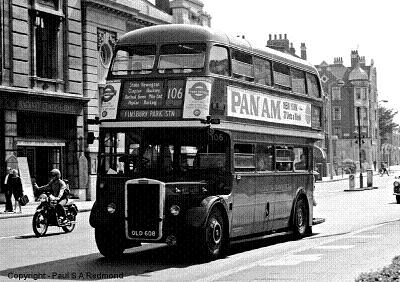
Station Place
Hackney's RTL1499 runs up Mare Street, which
it shares with a desirable Triumph twin, towards Finsbury Park
Stn.
Photo © Paul Redmond
Whilst the majority of bus routes serving Finsbury Park run
through along Seven Sisters Road, some services have always
terminated in front of the station in Station Place, where there is
now a new bus station. These have included Blackstock
Road routes 4/4A (introduced 1912 to Elephant &
Castle), 106/106A (to Poplar from 1915) and later
the 141A/179/179A group, plus periodic
use by Seven Sisters Road routes, including the 42 (before the
war, when it used to run beyond Aldgate via Clapton and
Stamford Hill), 39, 168A, 253A and 276.
The increasing congestion at Station Place led to the introduction
of alternative termini between the wars. However, in more
recent years, other routes have worked from Station Place,
including N19 from 1989 and 153 from 1992.
The workings from Blackstock Road were originally direct to
Seven Sisters Road, then clockwise into Station Place. This
changed in March 1926 to approach via Rock Street
and St Thomas's Road.
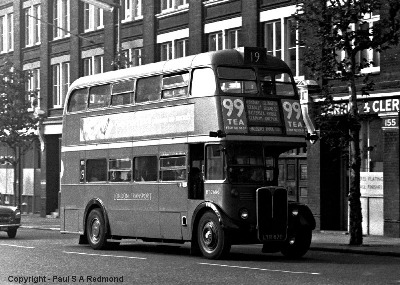
In early days, Station Place was also used
by services from the north-west. Introduced in 1914,
route 111 to Muswell Hill (which became the 212) ran under the Stroud Green Road bridge
to Seven Sisters Road and looped into Station Place (then Station
Road) to terminate. This changed in 1919 when
the terminal working became Stroud Green Road, Wells Terrace,
Fonthill Road, Seven Sisters Road, Station Road (stand), Stroud
Green Road. Perhaps the change was to enable inbound
passengers to alight and access the station via the Wells Terrace
entrance, but in 1922 the former working was re-introduced, at the
same time as the introduction of route 110 (later 210). The 111 was single-deck operated due
to a weak bridge on Muswell Hill, but in 1921 the General were
fined for operating double-deckers on the route. These would
have been open-top, and probably used Fonthill Road in
both directions to avoid the low Stroud Green Road bridge (as had
double-deck routes from Central London to Stroud Green, between
replacing horse buses in 1911 and withdrawal in 1920). In
February 1926, the Wells Terrace terminus became operational and
from the following month the 110 and 111 no longer passed under the
railway.
Holloway's RT2686 heads up
Rosebery Avenue, bound for Finsbury Park Plimsoll
Road.
Photo © Paul Redmond
Two routes operated by Enfield garage ran from Seven Sisters
Road under the bridge to terminate at Stroud Green. The 201
was introduced in 1927 and withdrawn south of Turnpike Lane in
1933. Independent Redburn's route 538 (later 238) was taken over by the General in
1926, received LT Scooters in 1931 and was withdrawn in 1938,
at which point the 236 (already
single-deck) was extended to Stroud Green. This remained the
only route to link the two halves of Finsbury Park until its
withdrawal from this section in 1982.
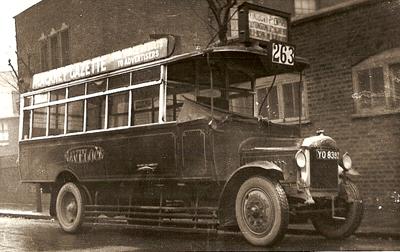
Rock Street
Havelock Motors was one of
the independents that operated on the 263 (later 236) in the 1920s. Dodson-bodied Dennis
2 ½-ton YO8392 shows the destination 'Finsbury Park
Empire'. Photo David Ruddom
collection
In 1926, alongside other changes to Station Place
workings, came the use of Rock Street as a terminus itself because
Station Place was becoming too busy. Independent route 550 to
Islington was introduced in January 1926, working from Rock
Street. This route lasted until April 1930, when it was taken
over by the General and replaced by the 273 to
Roehampton (itself renumbered 73 C in 1934).
The 273 terminus moved to Plimsoll Road in (or by) November
1930. New route 263 (which became the 236) from Leyton to London Fields was
extended at the end of 1926 to Finsbury Park Rock Street,
where only one bus was permitted to stand. In March
1927, the 19 group was extended from Highbury Barn to Finsbury Park
Rock Street. Both also moved to the Plimsoll Road
stand when it came into use.
At the junction of Rock Street and St Thomas's Road
stood the Empire Theatre
(which later on featured stars such as Tony Hancock and Cliff
Richard & the Drifters). This was the named destination
for some services, including some independent operators on the
263.
Plimsoll Road
This splendid view of
Plimsoll Road from the John Boylett collection shows that even in
1958, there were conflicts between car parking and buses. Two
TDs on the 236 and an RTL on the 19 lay over in the road, the
further two beyond the end of Prah Road but standing close to
a canteen trailer installed on a
vacant plot. The permanent canteen, located just in front of
TD110, opened later that year. Photo © John Boylett at
SCT61.
On (or by) 19 November 1930, the terminus for the 19
group (including the short-lived summer Sunday 119 to Kenley or
Croydon Airport) and the 263 (renumbered 236 in 1934) was moved to a stand at the Plimsoll
Hotel in Plimsoll Road. The stand was accessed 'via Prah
Road' after setting down in Rock Street, and buses returned to
service via St Thomas's Road and Seven Sisters Road.
Passengers were carried to the stand. The 273 (renumbered
73 C in 1934) also used Plimsoll Road from 1930 until its
withdrawal in October 1935.
It is unclear from the records, but from photographs it
appears the inbound routing was originally Prah Road, Romilly Road,
Ambler Road, whereas (as shown by the RF photo below) this
became Prah Road direct to the central part of Plimsoll Road,
perhaps because the stand was moved to outside the new
canteen. Whilst official working was always via Rock Street,
it is reported that certain journeys accessed Plimsoll Road
direct via Monsell Road. Does anyone know whether this occurred only if buses
were empty?
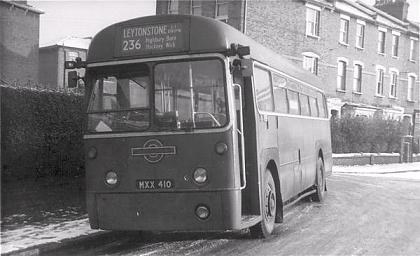 In addition to being a stand, Plimsoll Road was also
provided with a canteen, probably from 1953. Initially
this was the trailer, shown in the photo
of the TD, but later on a small permanent canteen was opened
on the south side of the road at its west end. The location
was the crew-change point for Tottenham crews on the 236 (see Pat
Spencer's Memories). The 236
crews were joined in the canteen by the Holloway
(J) workings of route 19, but not all of Battersea's,
most of which reportedly turned at Highbury Barn (where there was
also a mobile canteen) and changed crews at the garage. From
1969 to 1971, the Battersea workings on the 19 were replaced by the
19 A, which ran to Plimsoll Road.
Whilst the later stand was officially on the
left (south) side of Plimsoll Road, buses frequently spilled onto
the offside. Here RF433 has run in in snowy weather and been
abandoned for the warmth of the canteen. Students of London
architecture might like to compare this view of the building behind
the bus with today's view on Google Streetview.
Photo © Jim Blake, John Hinson
collection
The Sundays-only 106A (but not the weekday 106,
which continued to use the station) changed its terminus from
Station Place to Plimsoll Road in 1964. When replaced by
the 106 in 1971, the route used a different terminus on Sunday from
during the week.
This stand continued in use until about 1984, when a new bus
station and canteen were built in Station Place.
Wells Terrace
Muswell Hill-based Green
Line 6Q6 Q229 on the 210 heads for the Wells Terrace
stand, past West Green's Q142 on the 233 stand nearest to the
Stroud Green Road bridge, 25 Jun 52. Neither bus
survived the introduction of RFs.
Photo © Alan Cross, John
Hinson Collection
On the north side of the railway, the destination has always
been given as 'Finsbury Park Wells Terrace'. This
belies a series of changes over the years in the terminal workings,
which needed to combine access to the station with stand space for
several very frequent routes.
The first Wells Terrace stand came into use in February 1926,
when the 154 (later 233) was introduced.
At first, the 154 turned right from Stroud Green Road to
terminate along Wells Terrace, and on departure passed under the
coal-siding bridge and turned right into Clifton Terrace, right
into Lennox Road and left back onto Stroud Green Road. It was
joined in Wells Terrace in March, when the 110 (later 210) and 111 (later 212) ceased using Station Place. These
routes, however, worked the other way round the loop, so as to
terminate in Wells Terrace facing Stroud Green Road. In July,
the 154 working was reversed to work similarly. In
December 1930, all routes were reversed, so that they terminated on
the station side of Wells Terrace.
In 1947, the stand arrangements in Wells Terrace were changed
again, presumably as the road had become too congested. The
210 stand was moved forward to the south end of the road, so that
on departure buses turned into Fonthill Road then Lennox
Road. The 233 stand was nearest Stroud Green Road and the 212
was under the rail bridge. These stands feature in many
of the photographs of the period.
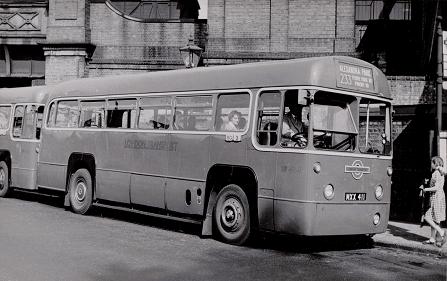
RF434 was new when photographed on the 233 in
Wells Terrace - note the absence of a horizontal rail across the
passenger windscreen.
Photo © JH Aston, Peter Gomm collection
Contrary to some suggestions, the coal-siding bridge did not
preclude the use of double-deckers; the coal yard branch line left
the main line south of the station and had time to climb to a
sufficient height. In 1955, double-deck working
was introduced on short journeys of the 233, and in 1960 the
whole of the 212 was double-decked. John Hambley's
London Transport Buses 1960 has a picture on page 27 of two RTs in
the road at Finsbury Park under the coal-siding bridge.
(There is a nice picture of a Scooter on the 212 in front of the
bridge here.)
On a number of occasions in the 1950s (apparently for extended
periods, and certainly including early 1958), while there were road
works or other disruption in either Wells Terrace or Stroud Green
Road, all terminal workings were reversed to
anti-clockwise and dolly stops were used for stands in Clifton
Terrace. Buses arrived from Lennox Road into Clifton Terrace
and departed via Wells Terrace, Fonthill Road and Lennox Road (with
some rogue drivers carrying on up Fonthill Road to Tollington
Park).
The anti-clockwise working, but exiting via Wells
Terrace, became permanent on 12 Jun 61. The 210,
233 and 212 Express laid over at two stops in Clifton
Rise, with the 212 Express nearer to Wells Terrace; the 210s stood
on the 212 Express stand off-peak and behind the 233 in peak
hours. The 212 Express and 233 boarded on
stand, whilst the 210 boarded in Wells Terrace closest to Stroud
Green Road. The 212 stood and boarded in Wells
Terrace (Stuart Perry notes that the
high-frequency 212 had very short layovers). Note that the
boarding for 212 and 212 Express was some distance apart, so you
couldn't queue for both.
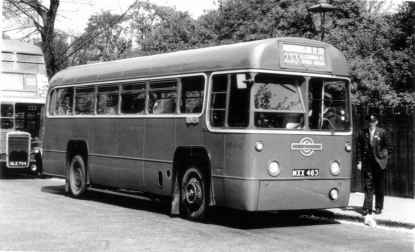 Two faces of the 233 in May 1958.
RF486 waits on the temporary stand in
Clifton Terrace in front of RTL1430, which is on the short working
to Alexandra Park. Two faces of the 233 in May 1958.
RF486 waits on the temporary stand in
Clifton Terrace in front of RTL1430, which is on the short working
to Alexandra Park.
Photo © RA Golds, Peter
Osborn collection
Following this reversal of working, there is a note in the March
1963 Central Road Services Traffic Committee minutes
that, following accidents arising from passengers crossing Wells
Terrace to reach Clifton Terrace, the Traffic Commissioners had
ruled that passengers may board only in Wells Terrace after the
buses have come off the stand in Clifton Terrace, although how
this avoids the problem isn't clear as they still had to cross
Wells Terrace. However, a proposal for a petrol station
[unspecified, but perhaps on the corner of Stroud Green Road and
Wells Terrace?] meant that the Wells Terrace stop would have to be
moved and the boarding point move back to Clifton Terrace. There
was therefore a proposal to reverse the working again, i.e. back to
clockwise, but with passengers still boarding in Clifton Terrace,
now on the offside, so creating a new risk. The Committee therefore
decided to explore the possibility of acquiring disused railway
land in Clifton Terrace.
The upshot of this discussion appears to have been the new
bus station that opened in Wells Terrace on 21 Apr 74, after the
coal-siding bridge had been removed in 1970. This allowed all
Stroud Green Road services to terminate here, namely the 210, W2
(which replaced the 212 Express as far as Alexandra Park), W3
(which replaced the 233) and W7 (which replaced the 212).
Meanwhile, for a brief period during the removal of the coal-siding
bridge, services were diverted from Clifton Terrace, right into
Wells Terrace then Fonthill Road and Lennox Road back into Stroud
Green Road.
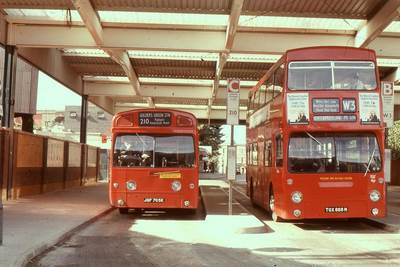 The new bus station in Wells
Terrace, seen when new in September 1974. The 210 is now SMS
operated and the W3 (the erstwhile 233) DMS. Both drivers
look rather bored, with no-one to talk to. Note the roof,
which was subsequently removed. The new bus station in Wells
Terrace, seen when new in September 1974. The 210 is now SMS
operated and the W3 (the erstwhile 233) DMS. Both drivers
look rather bored, with no-one to talk to. Note the roof,
which was subsequently removed.
Photo © Fred Ivey
Part of the redevelopment of the coal yard involved the building
of Morris Place, joining Clifton Terrace with Stroud Green
Road. On 26 Apr 82, inbound journeys to Wells Terrace were
rerouted to use Morris Place instead of Lennox Road. The
Wells Street bus station was rebuilt in the mid-2000s, requiring
temporary use of Lennox Road (inbound) and Morris Place (terminus
and outbound).
Postscript
The minutes of the Traffic Committee in 1964 describe the
replacement bus service required to cover the closure of the
Drayton Park to Finsbury Park section of the Northern City Line
during the Victoria Line construction. They calculate that 27 OMO
coaches are required for a 2 minute service in the peaks, but
haven't a hope of finding them or (more critically) the crews (this
being a period of acute staff shortage at LT), so they agree to put
the contract out. The working described is Wells Terrace
(west end, pick up), Fonthill Road, Isleden Road, Tollington Road,
Hornsey Road, Benwell Road, Bryantwood Road (stand at east end),
Drayton Park, Gillespie Road, St Thomas Road, Station Place, Stroud
Green Road, Lennox Road, Clifton Terrace, right into Wells Terrace
to stand (which must have got quite crowded). The operation
was worked with hired coaches, which were (not surprisingly) much
less used than the trains and soon reduced to 7 vehicles -
does anyone have any pictures or further information?
|